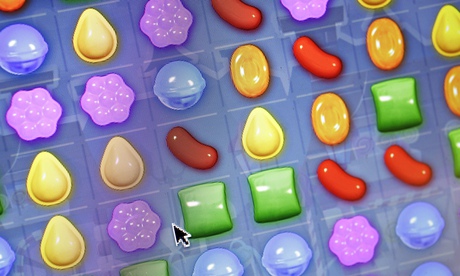
"Remember your first colour bomb?" says the voice on the ad. A fairly badly drawn stick-puppet girl and gorilla throw each other a chocolate sweetie covered in hundreds and thousands. The sweetie explodes in lightning bolts. Suddenly, many sweets appear, lined up in rows and columns. The lightning bolts hit them. "Tasty," says the voiceover. Whole lines of sweets vanish in zooming animation.
If this sounds like purest nonsense, you're not wrong. Although the ad ends with the encouragement to "download Candy Crush Saga now, for free", unless you're one of the estimated 500 million users of the developer King's game, none of that will have made any sense. It's not an ad designed to get you to download the game, not really.
Instead, it's designed to remind existing players of the thrill of success, to get them picking up their phone or logging on to Facebook for "just five minutes". Because the game is, as the ad says, free to download – it's only when you're playing, longing for an elusive "colour bomb", that you might be willing to pay King the few pence it'd take to get one.
This is a newish model for gaming, and one that is rapidly becoming the predominant way of doing game business on smartphones. It's called "freemium" – meaning that you get the game for free, but you have to pay to unlock certain features. Maybe you can only see some parts of the game if you pay. Maybe you can pay to speed up the replenishment of "lives". Maybe, as with Candy Crush, the game boards are calibrated to be almost-but-not-quite impossible to solve in the number of moves you get for free … but you can pay for extra moves when you've reached frustrated breaking point.
So what's going on here? What is the siren call of the colour bomb that would be worth King purchasing advertising space to entice players back to their phones? Why might these nonsense images actually work and persuade people to part with real cash?
Pondering these questions, I'm reminded of the philosopher Daniel Dennett's thinking on "supernormal stimuli". The term was coined by Nobel prizewinner Niko Tinbergen in his study of herring gull behaviour. Seeing that gull chicks pecked at the yellow-orange dot on their parent's beak to make the parent regurgitate food for them, Tinbergen presented the chicks with even bigger yellow-orange dots. He found that, as Dennett and Hurley say in their book Inside Jokes: "The chicks would peck even more vigorously at exaggerated orange spots, brighter and larger than any in nature."
Dennett suggested that the same basic principle applies to many areas of human life. "Our sweet tooth," he says, "is an evolved and instinctual preference for high-energy food. It wasn't designed for chocolate cake. Chocolate cake is a supernormal stimulus." We'll peck at the cake – as it were – in preference over the original stimulus, sweet fruits and berries. In Breaking the Spell, Dennett quotes Pascal Boyer, who suggests that music is a supernormal stimulus which mimics and heightens the effects of speech, and that we make symmetrical patterns with textiles, buildings, gadgets to deliberately "overstimulate [our] visual cortex".
In other words, we distil the part of an experience that gives us the "buzz". And then we make it happen again, and again, and again.
Maybe it's just all the talk of sugar and of coloured dots and of repetitive patterns of behaviour, but this seems very reminiscent of Candy Crush Saga. With 500 million users, that game is stimulating something in the human mind. I'm wary of evolutionary psychology – a field that too often seems to be simplified in the media down to "women like pink and men like teenage girls because of science" – but, with caveats, it's interesting if not particularly scientific to speculate about what supernormal stimulus buttons Candy Crush Saga might be pressing.
One drive it fulfils: the desire to feel that one has succeeded. That a task has been accomplished. The game can drip-feed players that feeling without ever letting you get to the stage of "and now I can stop". The game obviously fulfils the "bright colours, symmetrical shapes and simple sounds" elements of the supernormal stimulus theory. It might also fulfil our desire for order and tidiness – to "tidy up" all those pesky sweets. And perhaps the finding and matching of objects mimics tasks our brains are good at, but don't get to do very much any more, like searching for ripe fruit in tangled thickets, or picking stones out of dried lentils.
Whatever the answer, the nuanced position on supernormal stimuli isn't "ban them all" but "let's think carefully about how we want to live with them". Just because something is a supernormal stimulus doesn't mean it's bad for us – think music or visual arts. And sugar and alcohol are clearly supernormal stimuli, so we're continuing to debate and adjust our rules and societal norms about who gets unfettered access to them, what good limits are, and how often these things should appear in a "good life".
Adrian Hon, game creator and futurologist, recently suggested that we should introduce "nutrition facts" for freemium games, fact boxes that will let you know how much you're likely to spend on the game, and how to set limits on your playing time.
We need to recognise that we've created something magnificently compelling and pleasurable in video games – and that's a wonderful thing. And it's that magnificent compulsion that means we need to have a sane conversation about how to set limits for ourselves on another wonderful pleasure that has no natural limits.

